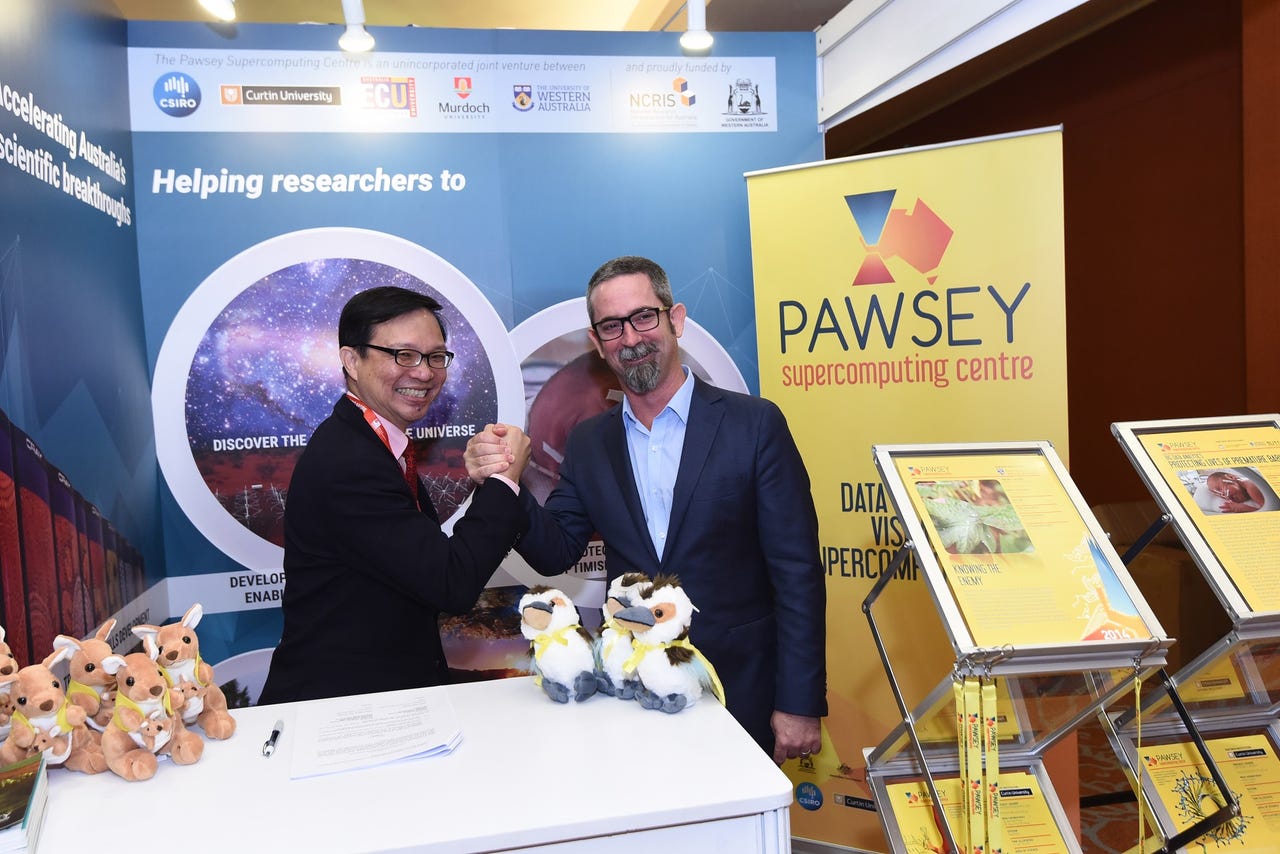Australia-Singapore supercomputing agreement signed


NSCC CEO Professor Tan Tin Wee and Pawsey's data technical specialist Mark Gray sign MOU
Australia's Pawsey Supercomputing Centre has announced the signing of a memorandum of understanding (MOU) with the National Supercomputing Centre (NSCC) of Singapore that will see both facilities work together on supercomputing, networking, data analytics, scientific software applications, and visualisation.
According to Pawsey, the MOU between the two facilities marks the start of their collaboration plan, which is aimed at delivering "better, faster, and more innovative" scientific outcomes for the benefit of both Australia and Singapore.
Based in Perth, the Pawsey Supercomputing Centre is a national supercomputing joint venture between the CSIRO, Curtin University, Edith Cowan University, Murdoch University, and the University of Western Australia.
It focuses on areas such as nanotechnology, radio astronomy, high energy physics, medical research, mining and petroleum, architecture and construction, multimedia, and urban planning.
The MOU is expected to enable the flow of knowledge between both centres, with Pawsey noting such knowledge transfer will in turn benefit the high-performance computing community within each country.
"The two supercomputing centres will collaborate in areas such as strategy, best practice and shared experiences in planning, defining, administering, and supporting industry engagement, outreach activities, training, and stakeholder management," Pawsey continued.
"Governance matters on resource access and sharing, resource allocation, export control, infrastructure accreditation; user support tools and methods; HPC software development and cybersecurity will also be considered."
See also: In pictures: The world's 25 fastest supercomputers (TechRepublic)
Both parties have plans in the pipeline which include joint initiatives to optimise researchers' activities, such as training and code optimisation, the Australian centre said.
"The proximity of the two facilities, similarities in storage solutions, but mostly creative thinking approach to problems, have driven Pawsey's interest in crystallising this relationship with NSCC," Pawsey acting executive director Ugo Varetto said.
"We are convinced that this type of initiative will enhance the services each centre provides, therefore researchers and their outcomes will be impacted. By working together, we aim to continue accelerating scientific discoveries in these two nations for the benefit of humanity".
While this is the first international agreement entered into by the Pawsey Supercomputing Centre, the centre said more will soon follow.
RELATED COVERAGE
HPE's SGI scores AU$1.5m CSIRO supercomputing contract
SGI will be replacing the decommissioned Fornax system at the Pawsey Supercomputing Centre in Western Australia.
Medical imaging at the 'speed of light': Nvidia's Clara supercomputer
Nvidia CEO and founder Jensen Huang said science needs super-charged computers, so that's why his company is building them.
NCI scores Raijin replacement and aims for top 25 supercomputer
National Computer Infrastructure at the Australian National University has picked up AU$70 million for an upgraded supercomputer.
It takes two to Tango: eRSA partners with Dell EMC for new research supercomputer
The non-profit IT service provider has welcomed a new high-performance computer and research cloud infrastructure, Tango.
Swinburne reaches for the sky with AU$4m astronomical supercomputer
The Dell EMC-powered supercomputer will be used by the university to power a new age of gravitational wave astrophysics, building on Albert Einstein's theory 100 years on.
Supercomputers coming soon to an office near you (TechRepublic)
Supercomputers are to ordinary servers as race cars are to street vehicles. Burst processing and cognitive applications are examples of tech that will be in the data centers or desktops of tomorrow.